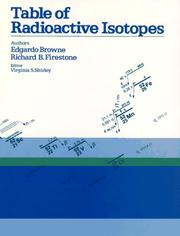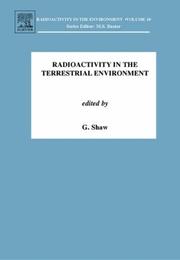| Listing 1 - 10 of 59 | << page >> |
Sort by
|

ISBN: 047184909X Year: 1986 Publisher: New York (N.Y.): Wiley
Abstract | Keywords | Export | Availability | Bookmark
 Loading...
Loading...Choose an application
- Reference Manager
- EndNote
- RefWorks (Direct export to RefWorks)
Table of Radioactive Isotopes By the Isotopes Project, Nuclear Science Division, Lawrence Berkeley Laboratory, Berkeley. The Table of Radioactive Isotopes is a comprehensive and critical evaluation of the nuclear and atomic properties of radioactive isotopes. The book is especially tailored to the needs of applied users in industry, biology, medicine, and other fields, but serves also as an indispensable reference for nuclear physicists and chemists. Detailed radiation data for about 2000 of the 2755 known nuclides are presented in this up-to-date and concise single-volume book. The main section of the book is organized by mass number (A), with entries for a given A derived from and referenced to the most recent corresponding evaluation in Nuclear Data Sheets or Nuclear Physics. These entries include a mass-chain decay scheme, showing the isotopes for that mass number, some of their properties, and the decay relationships between them. Following the scheme are tables for every isotope, the first of which gives the isotope's atomic number, mass number, element symbol, half-life, decay modes and branchings, mass excess, specific activity, means of production, and natural isotopic abundance. Subsequent tables list the isotope's nuclear and atomic radiations, and include total average energies per disintegration wherever possible. Throughout, the experimental radiation data have been analyzed for statistical consistency, and the resulting best energies and intensities are reported in the tables. Appendices of interest to users of radioactivity data follow the main section of the book. These include graphs and tables pertaining to the following: fundamental constants and conversion factors, standard [gamma]-ray and [alpha]-particle energies and intensities for detector calibration, theoretical internal conversion coefficients, electron-capture subshell ratios, electron binding energies, atomic fluorescence and Coster-Kronig yields, x-ray energies and intensities, Auge
Radioisotopes --- Isotopes radioactifs --- Tables --- -Radioactive isotopes --- Radioactive nuclides --- Radionuclides --- Isotopes --- Nuclear engineering --- Radioactive substances --- Radiochemistry --- Tables. --- -Tables --- Radioactive isotopes --- Monograph
Book
ISBN: 9535149199 9533075104 Year: 2011 Publisher: IntechOpen
Abstract | Keywords | Export | Availability | Bookmark
 Loading...
Loading...Choose an application
- Reference Manager
- EndNote
- RefWorks (Direct export to RefWorks)
The book Radioisotopes - Applications in Physical Sciences is divided into three sections namely: Radioisotopes and Some Physical Aspects, Radioisotopes in Environment and Radioisotopes in Power System Space Applications. Section I contains nine chapters on radioisotopes and production and their various applications in some physical and chemical processes. In Section II, ten chapters on the applications of radioisotopes in environment have been added. The interesting articles related to soil, water, environmental dosimetry/tracer and composition analyzer etc. are worth reading. Section III has three chapters on the use of radioisotopes in power systems which generate electrical power by converting heat released from the nuclear decay of radioactive isotopes. The system has to be flown in space for space exploration and radioisotopes can be a good alternative for heat-to-electrical energy conversion. The reader will very much benefit from the chapters presented in this section.
Radioisotopes. --- Radioactive isotopes --- Radioactive nuclides --- Radionuclides --- Isotopes --- Nuclear engineering --- Radioactive substances --- Radiochemistry --- Geophysics
Book
ISBN: 9282617106 Year: 1990 Publisher: Luxembourg Office for official publications of the European communities
Abstract | Keywords | Export | Availability | Bookmark
 Loading...
Loading...Choose an application
- Reference Manager
- EndNote
- RefWorks (Direct export to RefWorks)
Radioisotopes. --- MIGRATION --- Radioactive isotopes --- Radioactive nuclides --- Radionuclides --- Isotopes --- Nuclear engineering --- Radioactive substances --- Radiochemistry --- Report
Book
ISBN: 1504407008 Year: 2016 Publisher: New York : IEEE,
Abstract | Keywords | Export | Availability | Bookmark
 Loading...
Loading...Choose an application
- Reference Manager
- EndNote
- RefWorks (Direct export to RefWorks)
Performance specifications and testing methods for the evaluation of handheld instruments (also known as radionuclide identification devices or RIDs) used for the detection and identification of radionuclides, which emit gamma rays and, in some cases, neutrons, are contained in this standard. The specifications for general, radiological, environmental, electromagnetic and mechanical performances are given and the corresponding testing methods are described. The documentation to be provided by the manufacturer is listed as part of the requirements. Normative and informative annexes that provide guidance for the implementation of this standard are also included. (The PDF of this standard is available at no cost compliments of the Department of Homeland Security Domestic Nuclear Detection Office. http://standards.ieee.org/getN42/download/N42.34-2015.pdf). Scope: This standard specifies general, radiological, environmental, electromagnetic, and mechanical requirements,and associated test methods for handheld radionuclide identification devices (RIDs). Successful completion of the tests described in this standard should not be construed as an ability to identify all radionuclides in all environments. Purpose: This standard addresses instruments that are used to detect and identify radionuclides, display gamma-ray exposure rates, and when provided, indicate the presence of neutron radiation. The identification requirements established by this standard are based on the sources and source configurations defined in this standard. When an RID is used operationally, the configuration of a source or object being analyzed is typically unknown, which may cause other radionuclides or isotopes to be identified.
Radioisotopes --- Radioactive isotopes --- Radioactive nuclides --- Radionuclides --- Isotopes --- Nuclear engineering --- Radioactive substances --- Radiochemistry --- Standards. --- Radioactivity --- Instruments
Book
ISBN: 9535165763 9533077484 Year: 2011 Publisher: IntechOpen
Abstract | Keywords | Export | Availability | Bookmark
 Loading...
Loading...Choose an application
- Reference Manager
- EndNote
- RefWorks (Direct export to RefWorks)
The book Radioisotopes - Applications in Bio-Medical Science contains two sections: Radioisotopes and Radiations in Bioscience and Radioisotopes and Radiology in Medical Science. Section I includes chapters on medical radioisotope production, radio-labeled nano-particles, radioisotopes and nano-medicine, use of radiations in insects, drug research, medical radioisotopes and use of radioisotopes in interdisciplinary fields etc. In Section II, chapters related to production of metal PET (positron emission tomography) radioisotopes, 3-dimensional and CT (computed tomography) scan, SS nuclear medicine in imaging, cancer diagnose and treatments have been included. The subject matter will by highly useful to the medical and paramedical staff in hospitals, as well as researchers and scholars in the field of nuclear medicine medical physics and nuclear bio-chemistry etc.
Radiology. --- Radioisotopes. --- Radioactive isotopes --- Radioactive nuclides --- Radionuclides --- Isotopes --- Nuclear engineering --- Radioactive substances --- Radiochemistry --- Radiological physics --- Physics --- Radiation --- Radiology
Book
ISBN: 0738152811 Year: 2007 Publisher: New York : IEEE,
Abstract | Keywords | Export | Availability | Bookmark
 Loading...
Loading...Choose an application
- Reference Manager
- EndNote
- RefWorks (Direct export to RefWorks)
The performance requirements for hand-held radionuclide identifying instruments are described in this standard. The requirements stated are based on instruments used in support of efforts associated with the U.S. Department of Homeland Security.
Radioactivity --- Radioisotopes --- Radioactive isotopes --- Radioactive nuclides --- Radionuclides --- Isotopes --- Nuclear engineering --- Radioactive substances --- Radiochemistry --- Nuclear reactions --- Radiation --- Instruments --- Standards. --- Radioisotopes. --- Instruments.
Book
ISBN: 9811667985 9811667993 Year: 2022 Publisher: Singapore : Springer,
Abstract | Keywords | Export | Availability | Bookmark
 Loading...
Loading...Choose an application
- Reference Manager
- EndNote
- RefWorks (Direct export to RefWorks)
Radioisotopes --- Radioisotopes. --- Nuclear accidents. --- Environmental aspects. --- Accidents --- Environmental disasters --- Radioactive isotopes --- Radioactive nuclides --- Radionuclides --- Isotopes --- Nuclear engineering --- Radioactive substances --- Radiochemistry

ISBN: 1281003468 9786611003463 0080474896 0080438725 9780080438726 9780080474892 9781281003461 6611003460 Year: 2007 Publisher: Amsterdam ; Oxford : Elsevier,
Abstract | Keywords | Export | Availability | Bookmark
 Loading...
Loading...Choose an application
- Reference Manager
- EndNote
- RefWorks (Direct export to RefWorks)
The Radioactivity in the Environment Series addresses the key aspects of this socially important and complex interdisciplinary subject. Presented objectively and with the ultimate authority gained from the many contributions by the world's leading experts, the negative and positive consequences of having a radioactive world around us is documented and given perspective. In a world in which nuclear science is not only less popular than in the past, but also less extensively taught in universities and colleges, this book series will fill a significant educational gap. Radioact
Radioactive pollution. --- Radioisotopes. --- Radioactive isotopes --- Radioactive nuclides --- Radionuclides --- Isotopes --- Nuclear engineering --- Radioactive substances --- Radiochemistry --- Environmental radioactivity --- Nuclear pollution --- Radioactivity, Environmental --- Pollution --- Radioecology --- Radioactive waste disposal
Book
ISBN: 1789858283 1789858275 Year: 2020 Publisher: London, England : IntechOpen,
Abstract | Keywords | Export | Availability | Bookmark
 Loading...
Loading...Choose an application
- Reference Manager
- EndNote
- RefWorks (Direct export to RefWorks)
Radioisotopes. --- Stable isotopes. --- Earth sciences. --- Geosciences --- Environmental sciences --- Physical sciences --- Isotopes --- Radioactive isotopes --- Radioactive nuclides --- Radionuclides --- Nuclear engineering --- Radioactive substances --- Radiochemistry
Book
ISBN: 0408703237 Year: 1973 Publisher: London
Abstract | Keywords | Export | Availability | Bookmark
 Loading...
Loading...Choose an application
- Reference Manager
- EndNote
- RefWorks (Direct export to RefWorks)
Experimental nuclear and elementary particle physics --- Radiochemical laboratories --- Radioisotopes --- Laboratory manuals --- 621.039.8 --- -Radioactive isotopes --- Radioactive nuclides --- Radionuclides --- Isotopes --- Nuclear engineering --- Radioactive substances --- Radiochemistry --- Radioisotope laboratories --- Chemical laboratories --- Nuclear facilities --- Applications of isotopes generally: radioisotopes, stable isotopes --- Radiochemical laboratories. --- Laboratory manuals. --- -Applications of isotopes generally: radioisotopes, stable isotopes --- 621.039.8 Applications of isotopes generally: radioisotopes, stable isotopes --- -Radioisotope laboratories --- Radioactive isotopes
| Listing 1 - 10 of 59 | << page >> |
Sort by
|

 Search
Search Feedback
Feedback About UniCat
About UniCat  Help
Help News
News